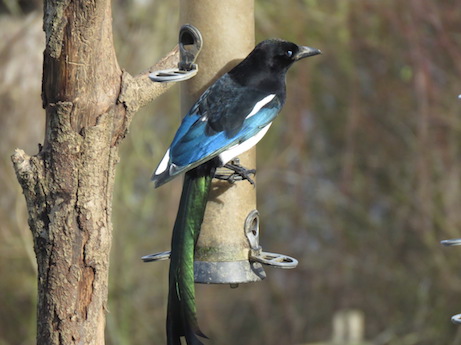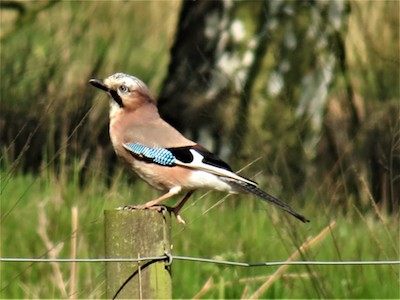Nature Notes – Colourful Corvids (Part Two)
In February we looked out for four, mainly black, members of the crow family. The other two species that can be seen locally are more colourful birds.
Magpie

Collectors of shiny things
All crows and some other bird families, e.g. bowerbirds in Australia, have the habit of collecting shiny objects to decorate their nests. Magpies are adept at this hence, ‘The Thieving Magpie.’ One of their other habits is less appealing. Magpies are excellent and prolific nest finders, especially when feeding their own young. Once a nest has been located the magpie will return repeatedly until all the eggs or chicks have been removed and eaten. If you have ever watched a blackbird building its well-hidden nest in garden shrubbery, only to have it systematically destroyed by a magpie, you may find it difficult to admire this beautiful bird.
Football colours plus!
At first appearance magpies are black and white (as all Newcastle United fans will confirm) with long tails and destructive habits. In good light, as the photograph shows, refracted light can turn the black feathers of magpies into dazzling blues and greens. These colours are described as structural caused by the structure of the feather not by pigments in the feather. The other interesting aspect of the photograph is the adaptability of this species; a large bird hanging from a feeder designed for finches and tits.
Finally, magpies share with long-tailed tits the peculiarity of building a nest that is ill suited to its long tail. A magpie nest is usual covered with a dome of sticks to reduce the risk of predation and is entered from the side. As a consequence the female incubates its clutch with its long tail bent around inside the ball structure.
Jay

Not common locally
Although jays are not common locally, they are relatively easy to find in East Leicestershire and Charnwood. Their preferred habitat is mature oak woodland. Jays gorge on nuts in the autumn, especiallyBuried Treasure
Although they have a high success rate at retrieving their buried “treasure,” not all buried acorns get re-found and the oak trees benefit from this unintended seed dispersal. Jays are, mainly, brown/pink birds with a bright blue wing patch and a white rump. They have a readily identifiable profile in flight with relatively short rounded wings and a long tail. As they often call when in flight (a harsh grating call) they readily draw attention to themselves. October is an excellent month to see jays. The British population is often joined by an influx from Europe, especially in years when the acorn crop elsewhere is less abundant than normal. Under these circumstances wandering jays often appear in areas outside the usual range of our breeding birds. Jays share with magpies the ability to find and eat the eggs and nestlings of smaller birds. Two other corvid species breed in Britain. The chough is glossy black with bright red legs and a convex red bill. It can be found in West Cornwall, West Wales, the Isle of Man and some Hebridean islands. The hooded crow is a black and grey bird closely related to the carrion crow. Hooded crows are common on European mainland but are restricted to Ireland and the north and west of Scotland. Occasional birds seen in England, mainly in winter, are mostly European birds. Summary Collectively crows are not always popular. They were recently described on radio as intelligent duckers and divers that demonstrate some of the worse traits of humanity.Other Corvids in Britain.




 Editorial.
Editorial.

